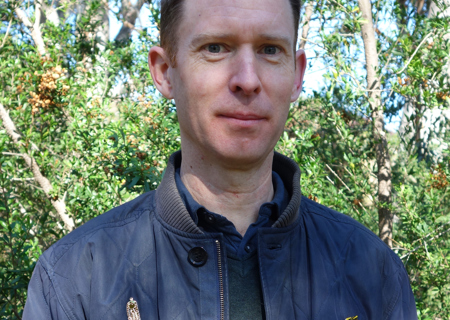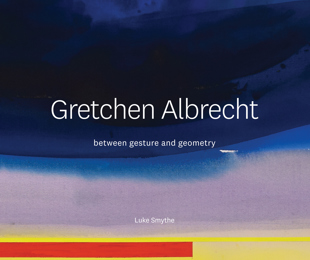Q1: This wonderful book has the most lovely subtitle: Between Gesture and Geometry. Could you explain why it’s so fitting?
Most abstract painters focus on one kind of imagery: either their work is geometric and thus feels orderly and disciplined, or else it’s organic and free-flowing and thus feels more sensuous and vital. Gretchen has the rare ability to bring the two together in her paintings and open up a third, more enigmatic space between them. Since most of the writing on her work focuses on her use of shape and colour, I wanted to call people’s attention to this overlooked dimension of her painting.
Q2: You have a long connection with Gretchen. Is that how you came to write the book?
One of my first memories is of going with my parents to Gretchen’s studio in downtown Auckland in the early 1980s to help them choose a painting to buy. I voted for a green and purple hemisphere, which is still in the family today! Years later, in the late 1990s, I catalogued Gretchen’s art, which is when the idea to write a book first came up. Gretchen and I stayed in touch while I worked and then studied overseas. When I returned to New Zealand several years ago, we could finally focus on the project.
Q3: Given her mana in the art world and her long and highly productive career, you must have had a keen sense of the challenge inherent in covering it all adequately. How did you go about structuring your research and your writing?
Gretchen has now been exhibiting for fifty years, so it was indeed a daunting prospect to do her entire career justice. Fortunately, her work divides quite neatly into series, which have emerged over the course of several decades. This gave me the book’s basic structure and I could then decide which works within each series I felt were most important. Research was more complicated, but between Gretchen’s studio notebooks, in which she jots down her thoughts about her work, the archives of museums and galleries, and the large body of writing on her art, I was able to be more comprehensive than previous authors. Where gaps in the written record needed filling, the artist and her husband, James Ross, were on hand to answer my many queries.
Q4: Was working on the book a collaboration with her, in essence?
It was important to me that Gretchen’s understanding of her art was recorded in the book. It was equally important, however, that the perspectives of the many critics and historians who have written insightfully on her work were also acknowledged. To the extent that all these voices intermingle with my own in the book’s pages, you could describe it as an interpretive collaboration.
Q5: Gretchen has a deep knowledge of art history and a keen intellect. The two of you must have had some terrific conversations.
Gretchen and I have had innumerable talks about art at her kitchen table over the years — accompanied in most cases by her cooking, which is an art of its own! She is indeed both knowledgeable and perceptive. Her responses to works she saw long ago are still vivid, and she’s just as good with poetry. She can still recite passages she first read as a teenager.
Q6: Why is she significant as an artist?
In the 1970s, she helped lead a shift in this country away from landscape painting toward abstraction. She did so, however, on her own, distinctive terms. Unlike most abstract artists in New Zealand at that time, who saw abstraction as something pure and sealed off from the wider world, she wanted the imagery to be richly associative. Initially, her paintings alluded to the landscape and thus kept in touch with the concerns of more established painters like McCahon and Woollaston. In the early 1980s, however, she started linking her imagery to other subjects and soon enmeshed in a vast — and still growing — web of connotations. Her work is beautiful, of course, but it’s the richness of the meanings it has accrued that makes it so engaging.
Q7: Are there particular Albrecht works that thrill you and move you?
Many. I find her group of ovals called The Seven Sorrows of Mary extremely moving, and love the drama of a hemisphere like Bright Mantled Ocean. Her collages of the late 1980s aren’t as well known as her shaped canvasses, but they should be. I love the way they seem disorganised at first glance but are, in fact, arranged very carefully.
Q8: Do they pull you back to look at them again and do you learn more each time?
Writing about art forces repeated looking and deeper learning. It’s one of the great rewards of the work.
Q9: What’s one new thing you learned when you were working on this book?
That abstraction is at its best when it’s at its most promiscuous and flirting with all manner of potential meanings.
Q10: What are you reading at the moment?
I’m making my third attempt on The Magic Mountain by Thomas Mann.


